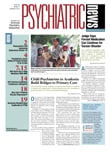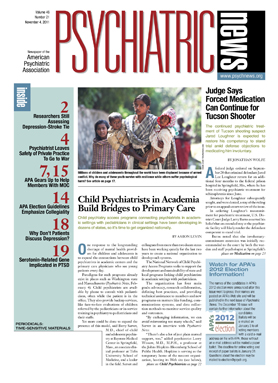Body dissatisfaction appears to be the major factor propelling young people on the road to eating disorders, an eight-year prospective study of adolescent girls suggests.
The study was headed by Eric Stice, Ph.D., a senior research scientist at Oregon Research Institute. The results were published in the October Behavior Research and Therapy.
The research by Stice and his team "provides a sort of roadmap for prevention interventions," Michael Devlin, M.D., clinical codirector of eating disorders research at the New York State Psychiatric Institute, commented to Psychiatric News. "Preventing the onset of eating disorders among those at risk is certainly preferable to intervening only after the disorders have become established."
The cohort in Stice's study included more than 400 middle-school girls with an average age of 14 who were recruited from four public schools and four private schools in the Austin, Texas, area.
They were evaluated at baseline with a number of instruments designed to measure putative eating disorder risk factors—perceived sociocultural pressure to be thin, thin-ideal internalization, body dissatisfaction, dieting practices, negative affectivity, and depressive symptoms. Semi-structured interviews were used to evaluate the subjects annually throughout the study for three DSM-IV eating disorders—anorexia nervosa, bulimia nervosa, and binge eating disorder—as well as for subthreshold versions of these disorders and for what the researchers dubbed "purging disorder" in which an individual had to have engaged in self-induced vomiting or diuretic/laxative use for weight control purposes at least eight times a month for three months.
By the end of the study, three subjects had developed anorexia nervosa, three subthreshold anorexia nervosa, six bulimia nervosa, 26 subthreshold bulimia nervosa, five binge eating disorder, 21 subthreshold binge eating disorder, and 22 purging disorder.
Body dissatisfaction emerged as the most potent predictor of development of an eating disorder. Subjects in the upper 24 percent of the body dissatisfaction measurement showed a fourfold increase in the incidence of an eating disorder relative to all those with lower dissatisfaction scores—24 percent versus 6 percent.
Furthermore, among the subjects in the high body dissatisfaction category, those in the upper 32 percent of depressive symptoms showed a threefold increased incidence of eating disorder relative to all those with lower depression scores—43 percent versus 15 percent.
And among the participants in the low body dissatisfaction category, those in the upper 12 percent of dieting showed a fourfold increased incidence of eating disorder relative to all those with lower dieting scores—18 percent versus 5 percent.
"This three-way interaction suggests a body dissatisfaction pathway to eating-disorder onset that is amplified by depressive symptoms, as well as a pathway characterized by self-reported dieting among young women who are more satisfied with their bodies," Stice and his colleagues concluded in their paper.
"These results are novel because no prospective study has investigated risk factors for onset of any eating disorder during the entire period of adolescence or tested for interactions among risk factors," they noted.
The researchers hope the results will "allow clinicians to identify youth at greatest risk for eating pathology, which can be a challenge because of the low incidence of these conditions. . . . The findings suggest that a brief body-dissatisfaction scale is the most sensitive method of identifying adolescent females at risk for onset of any eating disorder." But one also needs to keep in mind that even low body dissatisfaction accompanied by dieting is a risk factor.
And the results, they pointed out, might also assist in the design of eating disorder prevention programs that target key vulnerability factors. They have designed a brief eating disorder prevention program for young women who are determined to pursue thinness regardless of what the mental or physical costs might be. Participants engage in verbal, written, and behavioral exercises designed to produce cognitive dissonance—that is, conflict between thin-ideal messages and the participants' underlying values and beliefs—and this cognitive dissonance is hoped to change participants' minds about wanting to be thin.
"The program is being implemented by various organizations in the United States and several foreign countries," Stice told Psychiatric News. "The largest is Tri Delta Sorority, which is disseminating a version of this program … for sorority members."
The study was funded by the National Institutes of Health.
An abstract of "Risk Factors for Onset of Eating Disorders: Evidence of Multiple Risk Pathways From an Eight-Year Prospective Study" is posted at <www.sciencedirect.com/science/article/pii/S0005796711001306>.


